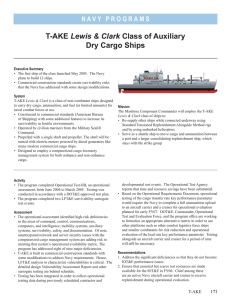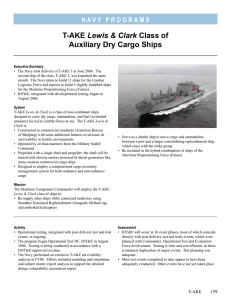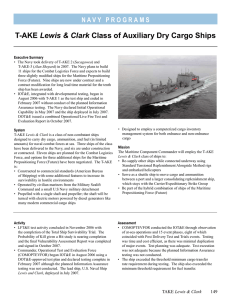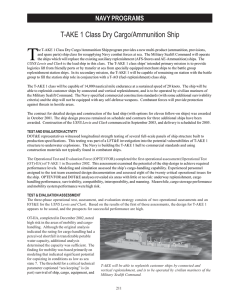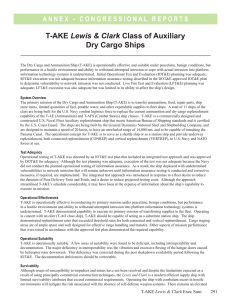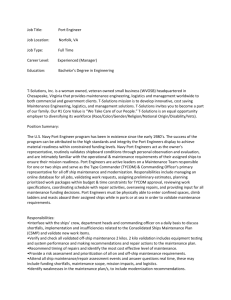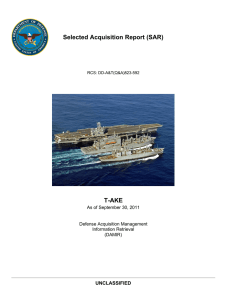Lewis & Clark Auxiliary Dry Cargo Ships
advertisement
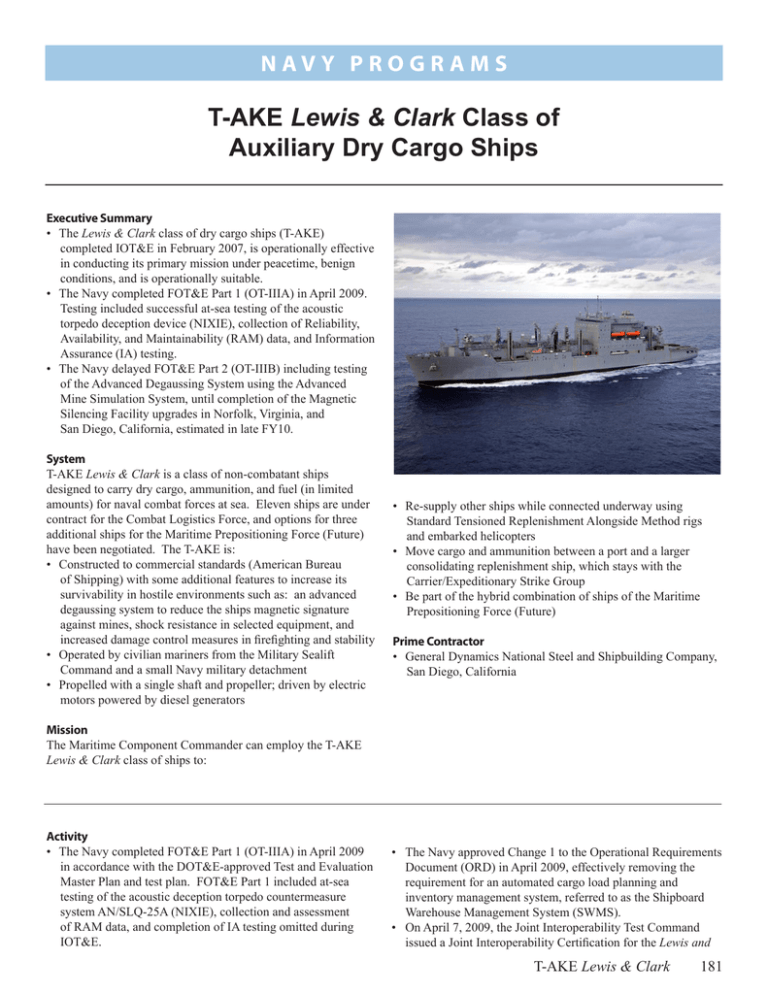
N a v y P ROGRA M S T-AKE Lewis & Clark Class of Auxiliary Dry Cargo Ships Executive Summary • The Lewis & Clark class of dry cargo ships (T-AKE) completed IOT&E in February 2007, is operationally effective in conducting its primary mission under peacetime, benign conditions, and is operationally suitable. • The Navy completed FOT&E Part 1 (OT-IIIA) in April 2009. Testing included successful at-sea testing of the acoustic torpedo deception device (NIXIE), collection of Reliability, Availability, and Maintainability (RAM) data, and Information Assurance (IA) testing. • The Navy delayed FOT&E Part 2 (OT-IIIB) including testing of the Advanced Degaussing System using the Advanced Mine Simulation System, until completion of the Magnetic Silencing Facility upgrades in Norfolk, Virginia, and San Diego, California, estimated in late FY10. System T-AKE Lewis & Clark is a class of non-combatant ships designed to carry dry cargo, ammunition, and fuel (in limited amounts) for naval combat forces at sea. Eleven ships are under contract for the Combat Logistics Force, and options for three additional ships for the Maritime Prepositioning Force (Future) have been negotiated. The T-AKE is: • Constructed to commercial standards (American Bureau of Shipping) with some additional features to increase its survivability in hostile environments such as: an advanced degaussing system to reduce the ships magnetic signature against mines, shock resistance in selected equipment, and increased damage control measures in firefighting and stability • Operated by civilian mariners from the Military Sealift Command and a small Navy military detachment • Propelled with a single shaft and propeller; driven by electric motors powered by diesel generators • Re-supply other ships while connected underway using Standard Tensioned Replenishment Alongside Method rigs and embarked helicopters • Move cargo and ammunition between a port and a larger consolidating replenishment ship, which stays with the Carrier/Expeditionary Strike Group • Be part of the hybrid combination of ships of the Maritime Prepositioning Force (Future) Prime Contractor • General Dynamics National Steel and Shipbuilding Company, San Diego, California Mission The Maritime Component Commander can employ the T-AKE Lewis & Clark class of ships to: Activity • The Navy completed FOT&E Part 1 (OT-IIIA) in April 2009 in accordance with the DOT&E-approved Test and Evaluation Master Plan and test plan. FOT&E Part 1 included at-sea testing of the acoustic deception torpedo countermeasure system AN/SLQ-25A (NIXIE), collection and assessment of RAM data, and completion of IA testing omitted during IOT&E. • The Navy approved Change 1 to the Operational Requirements Document (ORD) in April 2009, effectively removing the requirement for an automated cargo load planning and inventory management system, referred to as the Shipboard Warehouse Management System (SWMS). • On April 7, 2009, the Joint Interoperability Test Command issued a Joint Interoperability Certification for the Lewis and T-AKE Lewis & Clark 181 N a v y P ROGRA M S Clark class (T-AKE 1-5) after having satisfied all Net Ready Key Performance Parameters. • FOT&E Part 2 (OT-IIIB) is delayed until at least late FY10 due to delays in completing Magnetic Silencing Facility upgrades in Norfolk, Virginia, and San Diego, California. Assessment • T-AKE 4 successfully completed an acoustic trial off San Clemente Island and demonstrated that NIXIE was capable of masking the ships acoustic signature. • Although the ORD does not specify quantifiable RAM metrics, the Navy’s Operational Test Agency collected operational data on critical auxiliary support equipment during T-AKE 1 and 2 initial deployments. The data did not reveal any significant deficiencies. • Follow-on IA testing in T-AKE 5 with an installed Intrusion Detection System (IDS) was inconclusive. Although some detection capability was demonstrated, inadequate training in network administration prevented the system from operating in an effective protective posture without outside assistance. Only a portion of the servers and workstations were configured properly during the test. • Cost and technology problems associated with segregating classified and unclassified cargo inventory within the SWMS caused the Navy to remove the requirement for an automated cargo management system from the ORD. • Although T-AKE was delivered without a chemical agent point detection capability, the ORD specifies a requirement for one. 182 T-AKE Lewis & Clark There is space to allow installation once an adequate system is fielded. • The Navy is unable to test T-AKE for mine susceptibility using the Advanced Mine Simulation System until problems are resolved with the Advanced Degaussing System and the Navy completes the infrastructure upgrades to the Magnetic Silencing Facilities that will be used to calibrate these advanced systems. Recommendations • Status of Previous Recommendations. The Navy still needs to address one of the two FY06 recommendations and one of the six FY07 recommendations. • FY09 Recommendations. The Navy should: 1. Outfit all ships of the class with an IDS capability and ensure adequate training is provided to network administrators to foster effective IA. 2. Conduct additional FOT&E to verify the IDS works as designed and validate the ships ability to detect, react, and restore network systems in the event of an intrusion. 3. Pursue installation of a chemical agent point detection system as soon as the Navy fields a replacement. 4. Resolve problems associated with the ships Advanced Degaussing System, coordinate calibration for all ships once the Magnetic Silencing Facilities are available, and conduct FOT&E using the Advanced Mine Simulation System to assess mine susceptibility.
